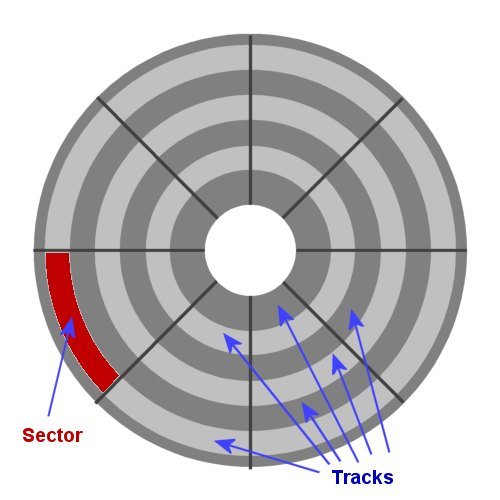The above picture
shows a disk removed from the cover. A real disk does not show the tracks and sectors as above.
As can be seen above a disk consists of "Tracks" and "Sectors", many more then what is shown on this disk.
The above would be considered a 6 track 8 sector disk, and is just made up to show how a disk works.
Most 5 1/4" disks used on the TI systems come in 4 flavors, Single-Sided Single-Density (SSSD), Single-Sided
Double-Density (SSDD), Double-Sided Single-Density (DSSD), and Double-Sided Double-Density (DSDD). The Stock,
TI Disk Controller is capable of Single-Sided Single-Density and Double-Sided Single-Density. You will need a
third party controller card such as a Cor-Comp or Myarc to be able to use the other two formats.
Single-Sided Single-Density (SSSD)
These disks are divided into 40 tracks or circles (as shown above) and they are numbered 0 - 39 starting
with the outside track and moving inward. Each track is divided into 9 sectors. So this type of format
would have 360 sectors ( 9 sectors X 40 tracks = 360 sectors ). These sectors are numbered from 0 to 359.
Now each sector holds 256 characters X 360 sectors, which equals 90K or 92,160 characters.
This is the type of disk drive that came with the PEB from TI.
Single-Sided Double-Density (SSDD)
These disks are also divided into 40 tracks, but each of these tracks are divided into 18 sectors.
18 sectors X 40 tracks = 720 sectors. Again, each sector holds 256 characters, so these disks hold
256 characters X 720 sectors equals 180K or 184,320 characters.
Double-Sided Single-Density (DSSD)
These disks are also divided into 40 tracks but use both sides of the disk. The tracks are numbered
from 0 to 39 starting from the outside track and moving inward. On the other side the tracks are numbered
from 40 to 79 starting from the insided track and moving outward. Again, each track is divided into 9
sectors. In this case there are 9 sectors X 80 tracks = 720 sectors. 256 characters X 720 sectors
= 180K or 184,320 characters.
Double-Sided Double-Density (DSDD)
These disks are also divided into 40 tracks on each side and numbered the same as DSSD disks. On these disks
each track is divided into 18 sectors. 18 sectors X 80 (40 each side) tracks = 1440 sectors. 256 characters X
1440 sectors = 360K or 368,640 characters.
|



